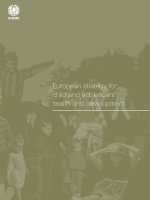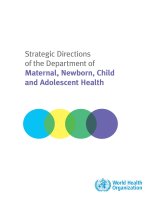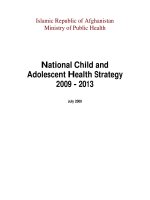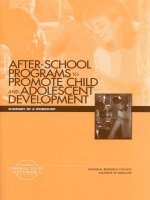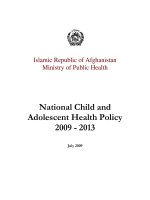AFTER-SCHOOL PROGRAMSTO PROMOTE CHILD AND ADOLESCENT DEVELOPMENT potx
Bạn đang xem bản rút gọn của tài liệu. Xem và tải ngay bản đầy đủ của tài liệu tại đây (287.55 KB, 73 trang )
Committee on Community-Level Programs for Youth
Jennifer Appleton Gootman,
Editor
Board on Children, Youth, and Families
Commission on Behavioral and Social Sciences and Education
National Research Council
and
Institute of Medicine
NATIONAL ACADEMY PRESS
Washington, D.C.
SUMMARY OF A WORKSHOP
AFTER-SCHOOL
PROGRAMS
TO
PROMOTE CHILD
AND
ADOLESCENT
DEVELOPMENT
NATIONAL ACADEMY PRESS 2101 Constitution Avenue, N.W. Washington, D.C. 20418
NOTICE: The project that is the subject of this report was approved by the
Governing Board of the National Research Council, whose members are drawn from
the councils of the National Academy of Sciences, the National Academy of Engineer-
ing, and the Institute of Medicine. The members of the committee responsible for the
report were chosen for their special competences and with regard for appropriate
balance.
The study was supported by Grant No. 99-7990 between the National Academy
of Sciences and the David and Lucile Packard Foundation. Any opinions, findings,
conclusions, or recommendations expressed in this publication are those of the author(s)
and do not necessarily reflect the view of the organizations or agencies that provided
support for this project.
International Standard Book Number 0-309-07179-8
Additional copies of this report are available from the National Academy Press, 2101
Constitution Avenue, N.W., Lock Box 285, Washington, D.C. 20055.
Call (800) 624-6242 or (202) 334-3313 (in the Washington metropolitan area)
This report is also available online at
Printed in the United States of America
Copyright 2000 by the National Academy of Sciences. All rights reserved.
Suggested citation: National Research Council and Institute of Medicine (2000) After-
School Programs to Promote Child and Adolescent Development: Summary of a
Workshop. Committee on Community-Level Programs for Youth. J.A. Gootman,
ed. Board on Children, Youth, and Families, Commission on Behavioral and
Social Sciences and Education. Washington, D.C.: National Academy Press.
The National Academy of Sciences is a private, nonprofit, self-perpetuating society of
distinguished scholars engaged in scientific and engineering research, dedicated to the
furtherance of science and technology and to their use for the general welfare. Upon
the authority of the charter granted to it by the Congress in 1863, the Academy has a
mandate that requires it to advise the federal government on scientific and technical
matters. Dr. Bruce M. Alberts is president of the National Academy of Sciences.
The National Academy of Engineering was established in 1964, under the charter of
the National Academy of Sciences, as a parallel organization of outstanding engineers.
It is autonomous in its administration and in the selection of its members, sharing with
the National Academy of Sciences the responsibility for advising the federal govern-
ment. The National Academy of Engineering also sponsors engineering programs
aimed at meeting national needs, encourages education and research, and recognizes
the superior achievements of engineers. Dr. William A. Wulf is president of the
National Academy of Engineering.
The Institute of Medicine was established in 1970 by the National Academy of
Sciences to secure the services of eminent members of appropriate professions in the
examination of policy matters pertaining to the health of the public. The Institute acts
under the responsibility given to the National Academy of Sciences by its congressional
charter to be an adviser to the federal government and, upon its own initiative, to
identify issues of medical care, research, and education. Dr. Kenneth I. Shine is
president of the Institute of Medicine.
The National Research Council was organized by the National Academy of Sciences
in 1916 to associate the broad community of science and technology with the
Academy’s purposes of furthering knowledge and advising the federal government.
Functioning in accordance with general policies determined by the Academy, the
Council has become the principal operating agency of both the National Academy of
Sciences and the National Academy of Engineering in providing services to the govern-
ment, the public, and the scientific and engineering communities. The Council is
administered jointly by both Academies and the Institute of Medicine. Dr. Bruce M.
Alberts and Dr. William A. Wulf are chairman and vice chairman, respectively, of the
National Research Council.
National Academy of Sciences
National Academy of Engineering
Institute of Medicine
National Research Council
v
COMMITTEE ON COMMUNITY-LEVEL
PROGRAMS FOR YOUTH
JACQUELYNNE ECCLES (Chair), Institute for Social Research,
University of Michigan
CHERYL ALEXANDER, School of Hygiene and Public Health, Johns
Hopkins University
BRETT BROWN, Child Trends, Inc., Washington, D.C.
SARAH BROWN, National Campaign to Prevent Teen Pregnancy,
Washington, D.C.
KENYON CHAN, College of Liberal Arts, Loyola Marymount
University
ELIZABETH COLSON, Department of Anthropology, University of
California, Berkeley
THOMAS COOK, Institute for Policy Research, Northwestern
University
PETER EDELMAN, Georgetown University Law Center
CASWELL EVANS, National Institutes of Health, Bethesda, Md.
RONALD FERGUSON, John F. Kennedy School of Government,
Harvard University
ROBERT GRANGER, Manpower Demonstration Research
Corporation, New York, N.Y.
TERESA LAFROMBOISE, School of Education, Stanford University
REED LARSON, Department of Human and Community
Development, University of Illinois, Urbana-Champaign
MILBREY McLAUGHLIN, School of Education, Stanford University
ROBERT PLOTNICK, School of Public Affairs, University of
Washington
ZENA STEIN, Joseph L. Mailman School of Public Health, Columbia
University
Jennifer A. Gootman, Study Director
Amy Gawad, Research Assistant
Drusilla Barnes, Senior Project Assistant
Elena Nightingale, Scholar-in-Residence
vi
FORUM ON ADOLESCENCE
1999-2000
DAVID A. HAMBURG (Chair), Carnegie Corporation of New York
(President Emeritus)
HUDA AKIL, Mental Health Research Institute, University of Michigan,
Ann Arbor
CHERYL ALEXANDER, Center for Adolescent Health, Johns Hopkins
University
CLAIRE BRINDIS, Institute for Health Policy Studies, Division of
Adolescent Medicine, University of California, San Francisco
GREG DUNCAN, Institute for Policy Research, Northwestern
University
JACQUELYNNE ECCLES, School of Education, University of
Michigan, Ann Arbor
ABIGAIL ENGLISH, Center for Adolescent Health & the Law, Chapel
Hill, North Carolina
EUGENE GARCIA, School of Education, University of California,
Berkeley
HELENE KAPLAN, Skadden, Arps, Slate, Meagher, and Flom, New
York
IRIS F. LITT, Division of Adolescent Medicine, Stanford University
JOHN MERROW, The Merrow Report, New York
ANNE C. PETERSEN, W.K. Kellogg Foundation, Battle Creek,
Michigan
KAREN PITTMAN, International Youth Foundation, Takoma Park,
Maryland
ANNE PUSEY, Jane Goodall Institute’s Center, University of Minnesota
MICHAEL RUTTER, Institute of Psychiatry, University of London
STEPHEN A. SMALL, Department of Child and Family Studies,
University of Wisconsin, Madison
CAMILLE ZUBRINSKY CHARLES, Department of Sociology,
University of Pennsylvania
BARUCH FISCHHOFF (Liaison, IOM Council), Social and Decision
Sciences, Carnegie Mellon University
ELEANOR E. MACCOBY (Liaison, Commission on Behavioral and Social
Sciences and Education), Department of Psychology (emeritus),
Stanford University
vii
BOARD ON CHILDREN, YOUTH, AND FAMILIES
1999-2000
JACK P. SHONKOFF (Chair), Heller Graduate School, Brandeis
University
EVAN CHARNEY (Vice Chair), Department of Pediatrics, University of
Massachusetts
JAMES A. BANKS, Center for Multicultural Education, University of
Washington
SHEILA BURKE, John F. Kennedy School of Government, Harvard
University
DAVID CARD, Department of Economics, University of California,
Berkeley
DONALD COHEN, Yale-New Haven Children’s Hospital, Yale
University
MINDY FULLILOVE, Columbia University
KEVIN GRUMBACH, Department of Family and Community
Medicine, Primary Care Research Center, University of California,
San Francisco
MAXINE HAYES, Department of Community and Family Health,
Washington State Department of Health
MARGARET HEAGARTY, Department of Pediatrics, Harlem Hospital
Center, Columbia University
RENEE JENKINS, Department of Pediatrics and Child Health, Howard
University
SHEILA KAMERMAN, School of Social Work, Columbia University
HARRIET KITZMAN, School of Nursing, University of Rochester
SANDERS KORENMAN, School of Public Affairs, Baruch College
CINDY LEDERMAN, Circuit Court, Juvenile Justice Center, Dade
County, Florida
SARA McLANAHAN, Office of Population Research, Princeton
University
VONNIE McLOYD, Center for Human Growth and Development,
University of Michigan
PAUL NEWACHECK, Institute of Health Policy Studies and
Department of Pediatrics, University of California, San Francisco
GARY SANDEFUR, Department of Sociology, University of Wisconsin,
Madison
viii
RUTH STEIN, Department of Pediatrics, Albert Einstein College of
Medicine
PAUL WISE, Department of Pediatrics, Boston Medical Center
RUTH T. GROSS (Liaison, IOM Board on Health Promotion and Disease
Prevention), Professor of Pediatrics (emeritus), Stanford University
ELEANOR E. MACCOBY (Liaison, Commission on Behavioral and Social
Sciences and Education), Department of Psychology (emeritus),
Stanford University
WILLIAM ROPER (Liaison, IOM Council), Institute of Medicine,
University of North Carolina, Chapel Hill
Michele D. Kipke, Director
Mary Graham, Associate Director, Dissemination and Communications
Mary Strigari, Administrative Associate
Elena Nightingale, Scholar-in-Residence
WORKSHOP ON OPPORTUNITIES TO PROMOTE CHILD
AND ADOLESCENT DEVELOPMENT DURING THE AFTER-
SCHOOL HOURS
PRESENTERS
JACQUELYNNE ECCLES (Workshop Chair), Institute for Social
Research, University of Michigan
MICHELE CAHILL, Carnegie Corporation of New York
JENNIFER DAVIS, Mayor’s Office, Boston, Massachusetts
JOY DRYFOOS, Hastings-on-Hudson, New York
ROBERT HALPERN, Erickson Institute, Chicago, Illinois
KAREN HEIN, William T. Grant Foundation, New York, New York
ROBIN JARRETT, Human and Community Development, University
of Illinois, Urbana-Campaign
MARY LARNER, Center for the Future of Children, The David and
Lucile Packard Foundation, Los Altos, California
JOAN LOMBARDI, Bush Center in Child Development and Social
Policy, New Haven, Connecticut
RICHARD NEGRON, Children’s Aid Society, New York, New York
TERRY PETERSON, U.S. Department of Education
KAREN PITTMAN, International Youth Foundation, Takoma Park,
Maryland
JANE QUINN, DeWitt Wallace-Reader’s Digest Fund, New York, New
York
ELIZABETH REISNER, Policy Studies Institute, Washington, D.C.
CARLA SANGER, LA’s BEST After School Enrichment Program, Los
Angeles, California
CARTER SAVAGE, Boys & Girls Clubs of America, Atlanta, Georgia
CONSTANCIA WARREN, Academy for Educational Development,
New York, New York
HEATHER WEISS, Harvard Family Research Project, Cambridge,
Massachusetts
NOTE: See the appendix for the full list of workshop participants.
ix
xi
Contents
PREFACE xiii
I
NTRODUCTION 1
POLICY ENVIRONMENT 3
D
EVELOPMENTAL CHALLENGES AND OPPORTUNITIES 7
D
ESCRIBING AFTER-SCHOOL PROGRAMS 12
C
OMPONENTS OF HIGH-QUALITY AFTER-SCHOOL PROGRAMS 17
THREE INNOVATIVE APPROACHES 20
E
VALUATING AFTER-SCHOOL PROGRAMS 27
B
RIDGING THE GAP IN RESEARCH, POLICY, AND PRACTICE 29
CONCLUSION 33
R
EFERENCES 35
A
PPENDIX: WORKSHOP AGENDA AND PARTICIPANTS 37
SELECTED REPORTS OF THE BOARD ON CHILDREN,
Y
OUTH, AND FAMILIES 53
xiii
Preface
This report summarizes the presentations and discussion at a work-
shop entitled Opportunities to Promote Child and Adolescent Develop-
ment During the After-School Hours, convened on October 21, 1999.
The workshop was organized by the Board on Children, Youth, and Fami-
lies and its Forum on Adolescence of the National Research Council and
the Institute of Medicine, with funding from the David and Lucile Packard
Foundation.
The workshop brought together policy makers, researchers, and prac-
titioners to examine research on the developmental needs of children and
adolescents—ages 5 to 14 years—and the types of after-school programs
designed to promote the health and development of these young people.
Intended to provide a forum for discussion among the various stakehold-
ers, the workshop did not generate conclusions about the types of programs
that are most effective, nor did it generate specific recommendations about
after-school programs or promote a particular approach.
The workshop coincided with release of the Packard Foundation’s fall
1999 issue of The Future of Children, entitled “When School Is Out.” Fo-
cusing on after-school programs, the journal provided some context for the
workshop, providing a backdrop for discussing the importance of after-
school programs, the types of programs that exist across the country, and
the policy climate that surrounds after-school programs. Although this
summary draws on “When School Is Out” to supplement specific state-
ments made at the workshop, neither the workshop nor this summary re-
xiv PREFACE
port incorporated the level of detail or scope of information contained in
that publication.
This volume draws on presentations and discussion at the workshop.
Of necessity, it reflects the particular emphases of the workshop presenta-
tions as well as specific statements made by presenters during the work-
shop. Although this report references published materials suggested or pro-
vided by workshop presenters, it is not intended to provide a comprehensive
or thorough review of the field.
The workshop was an effort to take stock of the current knowledge
base on after-school programs and highlight key findings from recent re-
search. It was also convened to help inform the future work of the Com-
mittee on Community-Level Programs for Youth, a new initiative of the
Board on Children, Youth, and Families and its Forum on Adolescence.
Given the limitations of both time and scope, the workshop could not
address all issues that are certainly very important when considering the
development, health, and well-being of children and adolescents during
after-school hours. It is our hope that this report will help to illuminate
important issues of after-school programs that deserve further attention
and consideration.
This report has been reviewed in draft form by individuals chosen for
their diverse perspectives and technical expertise, in accordance with proce-
dures approved by the Report Review Committee of the National Research
Council. The purpose of this independent review is to provide candid and
critical comments that will assist the institution in making the published
report as sound as possible and to ensure that the report meets institutional
standards for objectivity, evidence, and responsiveness to the study charge.
The review comments and draft manuscript remain confidential to protect
the integrity of the deliberative process.
We thank the following individuals for their participation in the re-
view of this report: James A. Banks, Center for Multicultural Education,
University of Washington, Seattle; Thomas Brock, Manpower Demonstra-
tion Research Corporation, New York, New York; Doug Kirby, ETR Asso-
ciates, Scotts Valley, California; Deborah Vandell, Department of Educa-
tional Psychology, University of Wisconsin; and Billie Young, Child
Development Programs for the City of Seattle, Department of Human
Services.
Although the individuals listed above provided constructive comments
and suggestions, it must be emphasized that responsibility for the final
PREFACE xv
content of this report rests entirely with the authoring committee and the
institution.
Many individuals deserve recognition for their contributions to the
workshop and this report. The workshop and this report were funded the
David and Lucile Packard Foundation. Special thanks go to Mary Larner
at the Packard Foundation for her assistance and support. Michele D.
Kipke, director of the Board on Children, Youth, and Families, conceptual-
ized and planned the workshop. Jennifer A. Gootman, study director of
the board’s Committee on Community-Level Programs for Youth, helped
organize the workshop and distilled its major themes into this summary
report. Other staff members who assisted with the workshop and the re-
port include Amy Gawad, Drusilla Barnes, and Zodie Makonnen. The
workshop benefited enormously from the insightful comments provided
by the workshop presenters.
Jacquelynne Eccles, Chair
Committee on Community-Level Programs
for Youth
AFTER-SCHOOL
PROGRAMS
TO
PROMOTE CHILD
AND
ADOLESCENT
DEVELOPMENT
1
INTRODUCTION
When schools all over the country are dismissed each afternoon, how
do the millions of children and adolescents spend their out-of-school time?
Increasingly, what children and adolescents do during after-school hours
has become a public concern among parents, educators, and policy makers.
“Familiar activities like sports, piano lessons, religious classes, and scout
troops still dot the afternoons and weekends of many children, but other
youngsters are adrift after school. Too many fend for themselves in librar-
ies, congregate in subway stations and neighborhood stores, or spend their
afternoons behind the locked doors of city apartments and suburban
houses” (David and Lucile Packard Foundation, 1999:4). Programs after
school and during weekends and summer hours may provide an opportu-
nity to engage these children and adolescents as partners in their own de-
velopment by ensuring that they have access to the kinds of constructive
learning and development opportunities that they both need and want dur-
ing their out-of-school time.
On October 21, 1999, under the auspices of the Committee on Com-
munity-Level Programs for Youth, a workshop was convened by the Board
on Children, Youth, and Families to review the current knowledge base
about after-school programs as a strategy for ensuring the safety, security,
development, and well-being of children and adolescents ages 5 to 14 and
to consider the implications of this knowledge for the next generation of
After-School Programs to Promote
Child and Adolescent Development
2 AFTER-SCHOOL PROGRAMS
after-school programs. This workshop was planned to coincide with the
release of the Packard Foundation’s fall 1999 issue of The Future of Chil-
dren, entitled “When School Is Out.”
To create a framework for workshop discussions, presenters were asked
to address the following questions:
1. What are the developmental needs, challenges, and opportunities
of children and adolescents ages 5 to 14?
2. What types of after-school programs are most likely to address those
needs?
3. What are the components of high-quality after-school programs?
4. What are the different models of after-school programs?
5. What are the challenges in evaluating these programs?
6. What should the next generation of research, policy, and design of
after-school programs look like?
This report summarizes the presentations and discussion that took
place at the workshop. It is not intended to provide a complete review of
the literature on adolescent development or after-school program evalua-
tion literature or to be an overview of all of the different types of after-
school programs. Rather, the report should be seen as a reflection of ideas
expressed by workshop presenters and participants that may lead to contin-
ued and enhanced support of existing programs, new program models, ad-
ditional and different research, and more collaboration among researchers,
policy makers, and practitioners.
Given the limitations of both time and scope, this workshop could not
address a variety of issues that are certainly important when considering
how children and adolescents spend their after-school hours. There was no
discussion about substantive evaluation findings that specifically demon-
strate the tangible impact of after-school programs on children and adoles-
cents. The workshop also did not examine the full range of after-school
programs that exist, review the evaluation and research literature on after-
school programs, nor the theory on which after-school programs are de-
signed. Workshop participants acknowledged the importance of after-
school programs in providing opportunities for developing cross-cultural
and intercultural skills, as well as the importance of staffing programs with
individuals who are sensitive to issues of diversity. However, the workshop
highlighted only the general developmental needs of children and adoles-
SUMMARY OF A WORKSHOP 3
cents and did not address specific identify issues faced by children and
adolescents who are ethnic minorities.
There is a large group of practitioners, researchers, and policy makers
committed to improving the quality and supply of after-school programs
for young people. This workshop engaged recognized leaders in the field,
and consequently the discussions at the workshop and this summary report
reflect only the views of those who participated.
It is important to note that there are a variety of terms used to describe
activities and programs for children and adolescents during their out-of-
school time. Additional discussion about these differences in terms of both
terminology and function can be found later in this summary report. How-
ever, for the sake of continuity here, we have chosen to use the term “after-
school program.”
POLICY ENVIRONMENT
Violence and Other High-Risk Behaviors
Violence among children and adolescents became front-page national
news during the late 1990s. Workshop presenter Karen Hein, of the Will-
iam T. Grant Foundation, pointed out that the highly publicized school
shootings that occurred in the communities of Littleton, Colorado,
Conyers, Georgia, and Johnsboro, Arkansas, in which children attacked
their classmates and teachers, have raised questions about the influence on
children and adolescents of how they spend their out-of-school time. Even
more widespread, though less publicized, are episodes of violence affecting
one or two young people at a time in and around schools throughout the
nation. For example, in Washington, D.C., recently, two successful high
school students were victims of a drive-by shooting following a basketball
game at their school. This football captain and his honor-student girl-
friend were just 2 of 17 high school students who met a violent death in the
District of Columbia since the school year began in September. Of these
17 slayings, 8 were precipitated by an argument that started at a school and
ended in gunfire on a neighborhood street (The Washington Post, February
16, 2000).
Research demonstrates that most delinquent behavior occurs during
the after-school hours, from 2:00 to 8:00 p.m. In addition, police and
other authorities report that risky behaviors, such as sexual activity and
drug and alcohol drug use, as well as juvenile crime, increase significantly
4 AFTER-SCHOOL PROGRAMS
from 3:00 to 6:00 p.m. (Fox and Newman, 1997). Hein explained that
after-school programs are emerging in the public consciousness as an inter-
vention to prevent violence and other high-risk behaviors as well as to pro-
mote the healthy development of children and adolescents.
Family Changes
An increased interest in after-school programs as a response to violence
among children and adolescents and in schools is fairly recent. There was
discussion among workshop participants that organized after-school pro-
grams began, in part, as a response to increased numbers of single-parent
households and working mothers and the resulting lack of caretakers at
home during after-school hours. In the past 30 years there have been sig-
nificant increases in the number of single parents and in the proportion of
families living in poverty. About 50 percent of all children today will reside
in a single-parent home before age 18, spending an average of 6 years with
a single parent (National Research Council and Institute of Medicine,
1999b). Furthermore, workshop presenter Terry Peterson, of the U.S. De-
partment of Education, explained that an estimated 28 million school-age
children have parents working at least part time, including 5 million to 7
million “latchkey children” who get no adult supervision after school
(Charles Stewart Mott Foundation, 1998). And 77 percent of married
mothers with school-age children worked outside the home in 1996 (U.S.
Bureau of the Census, 1997), most full time (U.S. Department of Health
and Human Services, 1997). Workshop presenter Jennifer Davis, of the
Boston 2:00-to-6:00 After-School Initiative, further explained that more
recently low-income parents who were previously on welfare have also
joined the work force as a consequence of welfare reform. Consequently,
after-school programs are increasingly being recognized as a safe and super-
vised place for children of parents who have to work during their children’s
out-of-school time.
School Performance and Academic Competence
Throughout the workshop, participants discussed the fact that increas-
ing concerns about student performance and pressures to improve lagging
academic achievement have also brought attention to the value of after-
school programs as a means to increase educational competencies and per-
formance. “In 1994, only 30 percent of the nation’s fourth and eighth
SUMMARY OF A WORKSHOP 5
graders scored at proficient or advanced levels in reading in the National
Assessment of Educational Progress” (David and Lucile Packard Founda-
tion, 1999:118). Children and adolescents spend only a small part of their
day in the classroom. Workshop presenters suggested that, in order for
schools to meet high state educational standards, after-school programs
could supplement academic learning through hands-on interactive activi-
ties. After-school programs have the flexibility to offer tutoring assistance,
lessons in problem solving, practice test taking, and fun skills-building ac-
tivities in a range of subjects, including math, reading, and science. All of
these opportunities may enrich young peoples’ academic curriculum and
lead to greater success in school.
Parents, Educators, and the Public
Various forms of after-school activities have been implemented in
schools and communities for decades, but after-school programs have in-
creasingly become the focus of solutions to practically every problem faced
by children and adolescents. There is increasing public conviction that
organized programs during after-school hours can prevent problem behav-
ior in children and adolescents as well as promote their health, develop-
ment, and well-being. Indeed, parents, educators, other adults in the com-
munity, and young people themselves endorse improving the supply,
quality, and access to after-school programs.
Workshop presenters Terry Peterson, of the U.S. Department of Edu-
cation, and Jane Quinn, of the DeWitt Wallace-Reader’s Digest Fund, pre-
sented the results of polls and studies of voters, educators, parents, and
adolescents about after-school programs that collectively argue for the need
for more and higher-quality after-school services:
• In a survey of the voting public conducted by a bipartisan polling
team, 93 percent of respondents favored making safe daily enrichment pro-
grams available to all children; 86 percent of voters thought that organized
after-school activities were a necessity; 11 percent of voters thought they
were not necessary (Charles Stewart Mott Foundation, 1988).
• In another survey, 84 percent of elementary school principals re-
sponded that in their communities there was a need for supervision both
before and after school (National Association of Elementary School Princi-
pals, 1988). Teachers who were surveyed singled out the need for after-
6 AFTER-SCHOOL PROGRAMS
school programs as critical to helping students with difficulties (Metropoli-
tan Life, 1994).
• In a survey conducted by the National Governors Association, over
50 percent of states indicated plans to increase funding and develop an
interagency structure to coordinate extra learning opportunities during af-
ter-school hours (National Governors Association, 2000).
• Children and adolescents also report that they want constructive
activities outside school. They want safe places to go where they can pre-
pare for their future, learn and practice new skills, and spend quality time
with caring adults and other children and adolescents (Quinn, 1999).
Increased Funding
As discussed by Peterson, in the past several years there has been a
dramatic increase in the level of federal and state funding for after-school
programs. For example, the U.S. Department of Education’s 21st Century
Community Learning Centers program experienced a dramatic increase in
funding: from $1 million in fiscal 1997 to $40 million in 1998, $200
million in 1999, and $450 million in 2000.
The focus of this school-based program, authorized under Title X, Part
I, of the Elementary and Secondary Education Act, is to provide expanded
learning opportunities for children in a safe, drug-free, supervised environ-
ment. The 21st Century Community Learning Centers enable schools to
stay open longer, providing a safe place for homework and tutoring, inten-
sive mentoring in basic skills, drug and violence prevention counseling,
college preparation courses, and enrichment in core academic subjects, as
well as opportunities to participate in recreational activities, chorus, band,
arts, technology education programs, and special services for children and
adolescents with disabilities. About 16,000 rural and inner-city public
schools in 471 communities—in collaboration with other public and non-
profit agencies, organizations, local businesses, postsecondary institutions,
and scientific/cultural and other community entities—are now participat-
ing as 21st Century Community Learning Center programs.
Other sources of public funding also support after-school program-
ming. A number of examples were mentioned at the workshop. The Safe
Schools/Healthy Students Initiative will provide $3 million annually from
education, mental health, and juvenile justice allocations to help 50 com-
munities provide school-based after-school programs, mentoring, and other
violence prevention activities. The DeWitt-Wallace Reader’s Digest Fund

